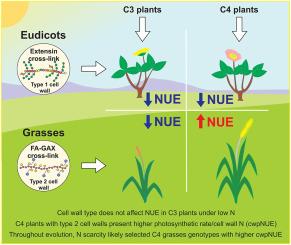评估细胞壁氮利用效率-细胞壁结构的差异是否有助于植物的氮经济性?
IF 5.7
2区 生物学
Q1 PLANT SCIENCES
引用次数: 0
摘要
C4植物比C3植物表现出更高的氮利用效率(NUE),这主要是由于C4植物对核酮糖-1,5-二磷酸羧化酶/加氧酶的需求较低。然而,植物氮素利用效率在C4植物中也存在差异,这表明细胞壁组成等其他因素对氮素经济也有影响。为了研究细胞壁结构对氮经济的贡献,我们比较了不同细胞壁类型的植物物种:具有I型细胞壁的菊苣植物(T1CW)和具有II型细胞壁的禾本科植物(T2CW),在缺氮、低氮、中氮和正常氮4种氮素水平下。通过比较具有不同光合代谢的物种,确认光合氮利用效率(pNUE)的已知差异;通过比较具有相似光合代谢但细胞壁类型不同的物种,评估细胞壁对氮经济性的影响。C4禾本科植物的光合效率高于C4菊科植物,从正常氮处理下的+ 54%增加到缺氮处理下的+ 81%。C4草在正常供氮条件下结构氮含量较低(- 26%),缺氮条件下结构氮含量较C4草低(- 58%)。一个探索性参数cwpNUE(光合速率/结构氮)表明C4草的光合速率(~ 1.1 μmol CO2 s-1 mmol-1细胞壁氮)远高于其他组(~ 0.5 μmol CO2 s-1 mmol-1细胞壁氮)。在正常氮肥条件下,酯联阿魏酸从C4草的+ 177%增加到缺氮条件下的+ 362%。数据支持这样的假设,即在炎热潮湿的热带环境中,氮成为C4植物生长发育的主要限制性养分。在T2CW中观察到的交联CW聚合物中延伸蛋白和FA-GAX的重叠表明,氮稀缺可能对C4草的适应施加了选择压力,从而促进了氮肥利用。本文章由计算机程序翻译,如有差异,请以英文原文为准。

Assessing the cell wall nitrogen use efficiency – Can the differences between cell wall architectures contribute to the nitrogen economy of plants?
C4 plants exhibit greater nitrogen use efficiency (NUE) than C3 plants, primarily due to lower ribulose-1,5-bisphosphate carboxylase/oxygenase requirements. However, plant NUE also varies among C4 species, suggesting that other factors, such as cell wall composition, contribute to nitrogen economy. To investigate the contribution of cell wall architecture to nitrogen economy, we compared plant species with distinct cell wall types: eudicots with type I cell walls (T1CW) and grasses with type II cell walls (T2CW), under four nitrogen regimes: deficit, low, medium, and normal. Species with different photosynthetic metabolisms were compared to confirm known differences in photosynthetic nitrogen use efficiency (pNUE), while species with similar metabolism but distinct cell wall types were compared assessing the influence of cell wall on nitrogen economy. The pNUE of C4 grasses was higher than that of C4 eudicots, increasing from +54 % in normal nitrogen to +81 % in nitrogen deficit. C4 grasses presented lower structural nitrogen (−26 %) in normal nitrogen supply, which decreased to −58 % in nitrogen deficit, in comparison to C4 eudicots. An exploratory parameter cwpNUE (photosynthetic rate/structural nitrogen) resulted in a much higher value in C4 grasses (∼1.1 μmol CO2 s−1 mmol−1 cell wall nitrogen) than in the other groups (∼0.5 μmol CO2 s−1 mmol−1 cell wall nitrogen). In turn, the ester-linked ferulic acid increased from +177 % in C4 grasses in normal nitrogen to +362 % in nitrogen deficit, when compared to C4 eudicots. Data supports the hypothesis that in hot, humid tropical environments, nitrogen became a major limiting nutrient for C4 plant growth and development. The overlap between extensins and FA-GAX in crosslinking CW polymers observed in T2CW suggest that nitrogen scarcity may have exerted a selection pressure for adaptations in C4 grasses to contribute to NUE.
求助全文
通过发布文献求助,成功后即可免费获取论文全文。
去求助
来源期刊
CiteScore
11.10
自引率
3.10%
发文量
410
审稿时长
33 days
期刊介绍:
Plant Physiology and Biochemistry publishes original theoretical, experimental and technical contributions in the various fields of plant physiology (biochemistry, physiology, structure, genetics, plant-microbe interactions, etc.) at diverse levels of integration (molecular, subcellular, cellular, organ, whole plant, environmental). Opinions expressed in the journal are the sole responsibility of the authors and publication does not imply the editors'' agreement.
Manuscripts describing molecular-genetic and/or gene expression data that are not integrated with biochemical analysis and/or actual measurements of plant physiological processes are not suitable for PPB. Also "Omics" studies (transcriptomics, proteomics, metabolomics, etc.) reporting descriptive analysis without an element of functional validation assays, will not be considered. Similarly, applied agronomic or phytochemical studies that generate no new, fundamental insights in plant physiological and/or biochemical processes are not suitable for publication in PPB.
Plant Physiology and Biochemistry publishes several types of articles: Reviews, Papers and Short Papers. Articles for Reviews are either invited by the editor or proposed by the authors for the editor''s prior agreement. Reviews should not exceed 40 typewritten pages and Short Papers no more than approximately 8 typewritten pages. The fundamental character of Plant Physiology and Biochemistry remains that of a journal for original results.

 求助内容:
求助内容: 应助结果提醒方式:
应助结果提醒方式:


